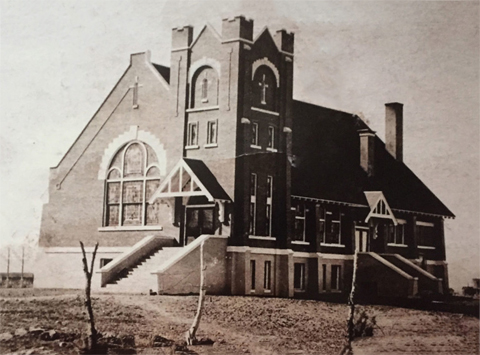The subject of this sketch, the closing chapter of whose life ended last Monday morning, was a pioneer in the fullest sense. He began “Blazing the Trail” when about eighteen years old, and continued the work of clearing the pathways that has made possible the great development of these mountain valleys for more than a quarter of a century.
Thomas Daniels was born in Brechfa, Carmarthenshire, South Wales, Jan. 18, 1831. In 1849 he came to Salt Lake with his parents where he resided until 1853, when he moved to Brigham, having married Mary Davis the year previous. The twelve years of his residence at Brigham, as well as the four years spent at the Salt Lake might be characterized as a battle with the elements; a continuous struggle to reclaim a barren desert and make it yield up its treasure. A struggle fraught with hardship and carried on for years against seemingly insurmountable obstacles with only the most primitive weapons to carry on the war of reclamation. Beginning his life under such conditions made Mr. Daniels, like nearly all that hardy little band of pioneers, a big, broad, patient man, and throughout his life he never shirked. He performed the duties that came to him with a patient zeal that made him a leading spirit in the great work of his time.
To record incidents in the life of this pioneer would mean writing the history of Utah from ‘49 to ‘65 and of this valley down to the present time. With the few hundred people of Utah he worked indefatigable and uncomplainingly. He fought grasshoppers and drought for years to save the crops that meant life to the people. He was in the “move south”, took part in the Mormon War and was one of the men who dug the pit for the cornerstone of the Salt Lake Temple.
In the winter of ‘64 Mr. Daniels first came into Malad valley and at that time he took the land where the old home still stands and also a tract down at the Big Bend. He returned to Brigham for the winter and came back here in April, 1865 and began to make preparations to receive his family later in the summer. He started to plow at the Bend on the 1st of May. In 1866 he lost his first wife and was left with six children to care for, all of whom are still living. Late in ‘67 or in the early part of ‘68 he married Mrs. Jannett Dines, a widow with five children, so he leaves a widow, fifteen children, seventy grand-children and twenty-seven great-grandchildren. In the 1870’s Mr. Daniels served two more terms as county commissioner, the only official position he held, though he was identified with nearly every public move in the history of the county from the time of its formation until death claimed him. He was one of the leading spirits in the move to have the county seat changed from Soda Springs to this place.
Everybody knew Thomas Daniels. He was respected as a man who had a winning fight against tremendous odds, and his greatness was in his uncomplaining, unassuming nature. Always ready with a helping hand for his weaker or less fortunate brothers, he made a place for himself in the hearts of the people that will enshrine his memory until the end of time.
May eternal peace and rest be his.
He died Monday morning, September 6, 1909
(Headshot picture of Thomas Daniels at the top center of the next page)
The rest of the writing is the same as the above.
(family picture of Thomas Daniels and Jeannette. On the Right top of page. Captions in writing says: Back-Joseph Dives, Verlum Dives, Henry Daniels, George Daniels, David John (Dom) Daniel. Front-Elva, Gertrude Dives, Janette Daniels, Annie Daniels, Sarah Daniels.
Thomas Daniels was a widower with five children when he married Jeannette, a widow with six children. The first morning of the honeymoon, the newlyweds sat down to breakfast with a combined family of eleven children. (Elva, George, Henry and Annie weren’t born yet so they didn’t have the honeymoon breakfast with the rest.)
George is one of eight children from that marriage. All but three of those 19 children lived to adulthood.
Two of Thomas Children by his first marriage married Jeannette’s children. George ways, “When anyone asks me who my sister Gertrude married, I tell them she married my brother Dave and my sister Sarah married my brother Tom.”
George recalls that as a child he slept with his brothers in the loft of the granary. Wheat was in the bins underneath. The girls slept on the floor in the house, where the bedding was stored in neat rolls during the daytime.
The family lived at American Falls for a time, pasturing livestock in the river bottoms where American Falls Reservoir is now located.
Indians lived nearby and often came to demand food. George remembers how frightened he was one day when an Indian chased him around their kitchen table with a butcher knife.
(Picture of log cabin bottom of the page. Caption says: Home of Thomas Daniels, Father of Dan M. Daniels, built in Malad in 1865.)
